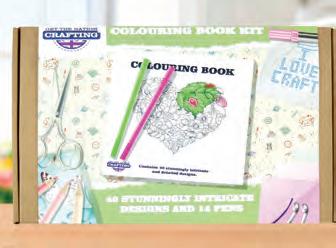
4 minute read
Colour Yourself Calm
Let your creativity run wild as you discover how Carla Bagshaw uses colouring in to improve her mental health Colour YourselfCALM
Three years ago, Carla Bagshaw was diagnosed with anxiety and depression. While medication helped her deal with crippling panic attacks, it didn’t stop the incessant overthinking that she describes as being on a ride she couldn’t get off. Carla explains: “I’m lucky in that I have a creative vocation, which I can lose myself in for hours. But because it is a job, there are other pressures attached to it. I needed something that wasn’t work, that didn’t take up huge swathes of room and that I could pick up and put down as needed to escape from my own head.” Carla tells us more about her journey using colouring in to boost her wellbeing.
Advertisement
You can create your own project by drawing a scribble on paper and then colouring in the spaces!
I discovered colouring in by accident
“I was trying to teach my then six-year-old how to stay in the lines with colouring pencils. He lost interest; I didn’t! I bought myself a colouring book and started to spend time using pencils and pens. And then something really interesting happened: I realised that I wasn’t colouring a picture, I was colouring in blocks of space that came together to create a picture.
“As I began to fill each block in, my mind started to wander to how best to shade that particular area and how to select complementary colours using the colour wheel so that the final aesthetic blended together. It was this thought process that stopped my overactive mind from spinning. Colouring in stopped time in my head. The physical ‘fight or flight’ response that my overactive adrenal glands generously heap on my stomach also stopped. There were just blocks of colour and quiet.”
Colouring in is an easy way to practise mindfulness
“It turns out that, medically speaking, the process of colouring in uses both sides of the brain’s cerebral cortex. You actually, subconsciously, use creativity and logic simultaneously. At the same time, you also begin to meditate – no need to try and be mindful, colouring in does it all for you!
“This process lowers the possibility of stressful thoughts entering your mind because you are already using that capacity on creativity and logic! Clever, eh?”
I love that colouring is just for me
“The other great benefit of colouring is that you are not creating for anyone else; this isn’t a card or present that you need to get right, which can be stressful if you are already overloaded. This is just a journey of self-expression that allows you to pick up very useful techniques as you go as an added benefit. These will be invaluable in furthering your creative potential. Another great joy of colouring is the accessibility. You can buy cheap colouring pages and books, super cheap pencils, or, even with very limited artistic ability, you can draw a scribble and colour it in.
“Adult colouring is, for me, a really beautiful experience. It is mine and mine alone. It doesn’t matter about the end result, and it doesn’t matter if I get bored halfway through and don’t finish. I use it daily now in my journaling as it brings

journal pages to life. I use it in card making, under my quilling work, on home décor pieces and, most importantly, just on its own. It is entirely experiential; it is being in the moment, without the burden of an overworked, anxious mind. Because, sometimes, escaping for an hour is the kindest gift I can give to myself.”
Head to the members area to print off and colour in your own version of Carla’s pretty mandala A journey of self-expression “Adult colouring is, for me, a really beautiful experience. It is mine and mine alone. It doesn’t matter about the end result, and it doesn’t matter if I get bored halfway through and don’t finish.” CARLA BAGSHAW
Blending with pencil crayons
“Pencil crayons are my favourite tool for colouring,” Carla says. “I often opt for them over pens; mistakes made with crayons seem more forgiving than mistakes made with pens. But I didn’t know how to blend pencil crayons. I had always thought that pressing harder around the edges to make the colour more opaque was blending, but I was wrong! That does help with shading, but it also stands out like a sore thumb.
“Do you need fancy pencils to blend? Absolutely not. You just need a white pencil crayon. Work in a circular motion over the dark edge and the lighter colour and the two will blend together beautifully. Colouring in a circular motion always creates a more fluid look than colouring in straight lines.
“You can also buy blending agents and use a paper stump to blend, but these steps are not necessary for beginners. If you want to experiment further, try using a tiny amount of baby oil on a cotton bud and rubbing between two colours – but be careful if you’re using cheaper paper.” BUY
NOW
on this page TEMPLATE DOWNLOAD Free! createandcraft.com/gb /members-area



Try it yourself!
Get to grips with mindfulness with this all-in-one colouring kit containing pictures and pens to get you started
Create and Craft Colouring Kit (545531) Price £14.99 Club Member Price £5.99











